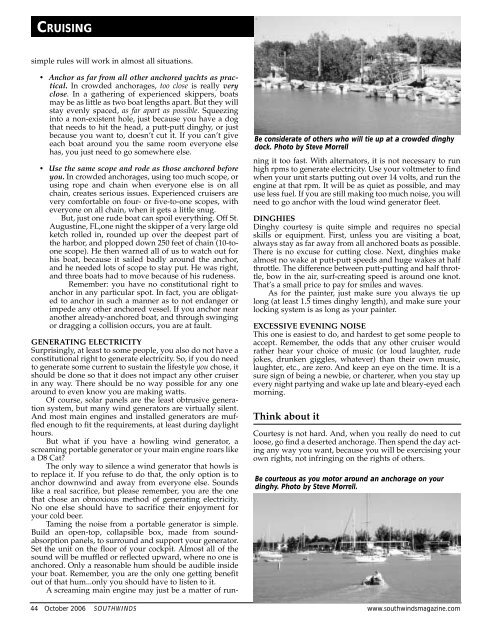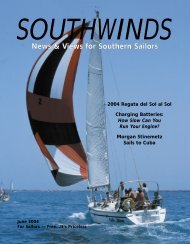News & Views for Southern Sailors - Southwinds Magazine
News & Views for Southern Sailors - Southwinds Magazine
News & Views for Southern Sailors - Southwinds Magazine
- No tags were found...
You also want an ePaper? Increase the reach of your titles
YUMPU automatically turns print PDFs into web optimized ePapers that Google loves.
CRUISINGsimple rules will work in almost all situations.• Anchor as far from all other anchored yachts as practical.In crowded anchorages, too close is really veryclose. In a gathering of experienced skippers, boatsmay be as little as two boat lengths apart. But they willstay evenly spaced, as far apart as possible. Squeezinginto a non-existent hole, just because you have a dogthat needs to hit the head, a putt-putt dinghy, or justbecause you want to, doesn’t cut it. If you can’t giveeach boat around you the same room everyone elsehas, you just need to go somewhere else.• Use the same scope and rode as those anchored be<strong>for</strong>eyou. In crowded anchorages, using too much scope, orusing rope and chain when everyone else is on allchain, creates serious issues. Experienced cruisers arevery com<strong>for</strong>table on four- or five-to-one scopes, witheveryone on all chain, when it gets a little snug.But, just one rude boat can spoil everything. Off St.Augustine, FL,one night the skipper of a very large oldketch rolled in, rounded up over the deepest part ofthe harbor, and plopped down 250 feet of chain (10-toonescope). He then warned all of us to watch out <strong>for</strong>his boat, because it sailed badly around the anchor,and he needed lots of scope to stay put. He was right,and three boats had to move because of his rudeness.Remember: you have no constitutional right toanchor in any particular spot. In fact, you are obligatedto anchor in such a manner as to not endanger orimpede any other anchored vessel. If you anchor nearanother already-anchored boat, and through swingingor dragging a collision occurs, you are at fault.Be considerate of others who will tie up at a crowded dinghydock. Photo by Steve MorrellGENERATING ELECTRICITYSurprisingly, at least to some people, you also do not have aconstitutional right to generate electricity. So, if you do needto generate some current to sustain the lifestyle you chose, itshould be done so that it does not impact any other cruiserin any way. There should be no way possible <strong>for</strong> any onearound to even know you are making watts.Of course, solar panels are the least obtrusive generationsystem, but many wind generators are virtually silent.And most main engines and installed generators are muffledenough to fit the requirements, at least during daylighthours.But what if you have a howling wind generator, ascreaming portable generator or your main engine roars likea D8 Cat?The only way to silence a wind generator that howls isto replace it. If you refuse to do that, the only option is toanchor downwind and away from everyone else. Soundslike a real sacrifice, but please remember, you are the onethat chose an obnoxious method of generating electricity.No one else should have to sacrifice their enjoyment <strong>for</strong>your cold beer.Taming the noise from a portable generator is simple.Build an open-top, collapsible box, made from soundabsorptionpanels, to surround and support your generator.Set the unit on the floor of your cockpit. Almost all of thesound will be muffled or reflected upward, where no one isanchored. Only a reasonable hum should be audible insideyour boat. Remember, you are the only one getting benefitout of that hum...only you should have to listen to it.A screaming main engine may just be a matter of runningit too fast. With alternators, it is not necessary to runhigh rpms to generate electricity. Use your voltmeter to findwhen your unit starts putting out over 14 volts, and run theengine at that rpm. It will be as quiet as possible, and mayuse less fuel. If you are still making too much noise, you willneed to go anchor with the loud wind generator fleet.DINGHIESDinghy courtesy is quite simple and requires no specialskills or equipment. First, unless you are visiting a boat,always stay as far away from all anchored boats as possible.There is no excuse <strong>for</strong> cutting close. Next, dinghies makealmost no wake at putt-putt speeds and huge wakes at halfthrottle. The difference between putt-putting and half throttle,bow in the air, surf-creating speed is around one knot.That’s a small price to pay <strong>for</strong> smiles and waves.As <strong>for</strong> the painter, just make sure you always tie uplong (at least 1.5 times dinghy length), and make sure yourlocking system is as long as your painter.EXCESSIVE EVENING NOISEThis one is easiest to do, and hardest to get some people toaccept. Remember, the odds that any other cruiser wouldrather hear your choice of music (or loud laughter, rudejokes, drunken giggles, whatever) than their own music,laughter, etc., are zero. And keep an eye on the time. It is asure sign of being a newbie, or charterer, when you stay upevery night partying and wake up late and bleary-eyed eachmorning.Think about itCourtesy is not hard. And, when you really do need to cutloose, go find a deserted anchorage. Then spend the day actingany way you want, because you will be exercising yourown rights, not infringing on the rights of others.Be courteous as you motor around an anchorage on yourdinghy. Photo by Steve Morrell.44 October 2006 SOUTHWINDS www.southwindsmagazine.com
















